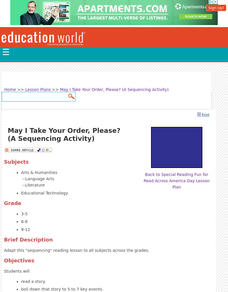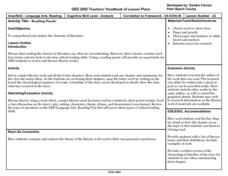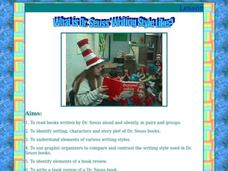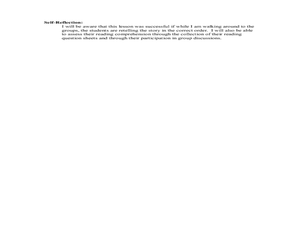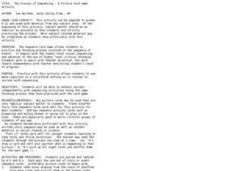Curated OER
May I Take Your Order, Please?
Pupils read a story, boil down that story to 5 to 7 key events, create a sequencing quiz to go with the story and have their classmates take the quiz. They will the strategy of sequencing by reading various stories (that they are not...
Curated OER
Frankenstein
Share a classic novel with your class using this resource. After reading Frankenstein by Mary Shelley, learners answer questions involving the narrator's point of view, make and confirm predictions, and sequence events in the story.
Curated OER
Australian Aboriginal Art And Storytelling
Students explore Aboriginal storytelling traditions through the spoken word and through visual culture. They listen to stories of the Dreamtime told by the Aboriginal people and investigate Aboriginal storytelling in contemporary dot...
Curated OER
Juan Verdades
Cement comprehension skills using the strategies in this activity. After reading the story, Juan Verdades by Joe Hays, learners use context clues to answer questions, identify main ideas and details, and sequence events.
Curated OER
A Day in the Life of Me
Young scholars respond to the text, A Day in the Life of Me. In this literature instructional activity, students discuss the sequence of events in the story and write simple sentences with a sketch of each important event.
Curated OER
Holes
Students read and analyze the story elements of the novel "Holes" by Louis Sachar. They play a "Holes" matching game, complete a timeline of story events, complete a Cause-and-Effect graphic organizer, conduct research on Louis Sachar's...
Curated OER
An Amazing Story
Pupils develop sequential stories to guide a partner through a computer-generated maze. In pairs they illustrate each place and character listed, build and print a maze, and write a class-generated story.
Curated OER
Ronald Morgan Goes to Bat
Second graders dramatize the sequence of events in the story Ronald Morgan Goes to Bat. In this dramatic arts lesson, 2nd graders read the book and create a dialogue for the play. Students gain insight into the sequence of events in the...
Curated OER
Reading Puzzle
Twelfth graders examine the elements of literature. They each read a chapter of a novel, sequentially list the main ideas, present a summary of the chapter to the class, sequence the events, and review the novel by summarizing the timeline.
Pearson
Rumpelstiltskin
Classic fairy tales are great! They have memorable characters, present interesting story lines, and lend themselves to art projects. Grab a copy of "Rumpelstiltskin" and get ready to participate in several early literacy activities. The...
Curated OER
The Very Clumsy Click Beetle
Second graders determine what it means to be clumsy before listening to Eric Carle's, The Very Clumsy Click Beetle. They examine the part where the click beetle does flips before drawing three frames that show the beetle flipping. For...
Curated OER
The Very Hungry Caterpillar
Students complete various activities related to the book "The Very Hungry Caterpillar." They participate in a shared reading activity, read and write a sentence for each day of the week, draw a picture of the caterpillar eating one of...
Curated OER
Billy Brown and The Belly Button Beastie
Students read and discuss the book, Billy Brown and the Belly Button Beastie. In this children's literature lesson, students read the book and participate in a discussion about the sequence of events in the text. Students create a...
Curated OER
Miss Nelson is Missing
Learners examine the story elements in the book, Miss Nelson is Missing. In this literary elements lesson, students listen to the story and identify the sequence of events in the test. Learners also use an online dictionary to define the...
Curated OER
Dr. Seuss
Learners read books by the same author and compare what they find. In this Dr. Seuss instructional activity, students learn about Dr. Seuss' writing style, listen for the rhyme scheme in his stories, and create a KWL chart on Dr....
Curated OER
Story Sequencing Strips
In this story sequence worksheet, students cut out the sequence strips and write what happens in their story in the order they occur. Students link them together to form a chain.
Curated OER
The Very Hungry Caterpillar: A Sequencing Lesson
Students listen to "The Very Hungry Caterpillar" and summarize to story to demonstrate comprehension. They review the days of the week and create their own book.
Curated OER
The Little Hungry Caterpillar
Students discuss "The Little Hungry Caterpillar." In this reading comprehension lesson plan, students make sock caterpillars used in retelling the story so as sequence the events accurately.
Curated OER
Life Cycles: A Never-Ending Story
Second graders describe the sequence of events in the life cycles of a butterfly, frog, and a deer. They observe the differences and similarities of parents and babies. They also discover that at different stages the animals can be...
Curated OER
Insects
It's a fact: kids love bugs! With this lesson, young learners explore reading informational texts and conducting research while learning about their favorite insects. Spark learners' interest by reading a book about one kind of bug and...
Curated OER
Time: Attribute
Students participate in five teacher-led, whole class activities that explore sequences of time and the concept of faster and slower. They sequence school day events, create a book of their daily schedule, put the days of the week in...
Curated OER
Zoom! Zoom! Zoom! I'm Off to the Moon Sequencing Lesson
Students practice sequencing. In this sequencing lesson, students listen to the book Zoom! Zoom! Zoom! I'm Off to the Moon. They put the story events in sequential order using a graphic organizer.
Curated OER
Sequence and Retell - The Napping House
Students sequence the story The Napping House by keeping trace of the characters in order. In this sequencing lesson plan, students also retell the story as they sequence.
Curated OER
The Process of Sequencing- A Picture Card Game Activity
Students put the events of a story in the correct order. In this sequencing lesson, students are paired up and labeled A or B. Students in each group receive a set of story or event sequence cards and they take turns drawing...
